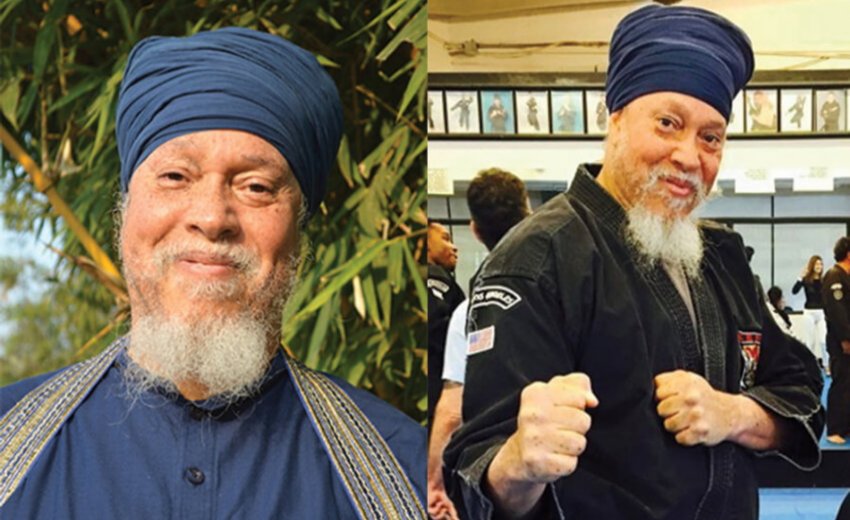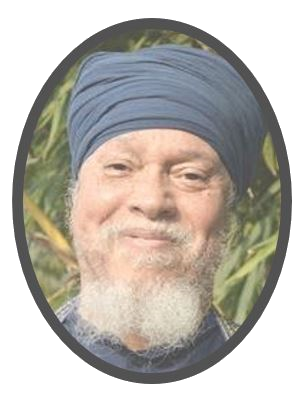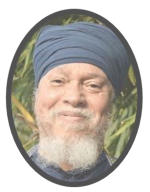Double Minority
SS Gurujodha Singh Khalsa
I am an African American man who is a Sikh.
When I was 12, my grandfather who was a chauffeur for a wealthy man in western Pennsylvania gave me a 10 speed bike for my birthday. It was a beautiful white and purple ten speed racing bike with curved handle bars and it gave me the freedom to ride all over my neighborhood with my friends, all of whom were Black. One Saturday, I had been instructed by my father to be home by 3 p.m. for a special family event. That morning I got on my bike and road north from my home in Germantown into new and uncharted territory in a predominantly white neighborhood with my friends. After several hours of riding and knowing I needed to be back by 3 p.m., my friends and I headed home.
About halfway home, a Philadelphia police patrol car pulled in front of us and ordered us all off of our bikes. A white officer approached me and taking my bike from my hands said, “Where did you get this bike?” I explained my grandfather had given it to me for my birthday. He turned the bike upside down to read and write down the bike serial number. He walked over to his vehicle and spoke to another officer and then came back and said, “Alright, go on home. You know you kids don’t belong in this neighborhood.” When I got home, it was well past 3:00 p.m. My father was furious. He asked me why I was late and I told him the story of my interaction with the police. He turned away from me briefly and when he turned back I could tell he was still very angry, just not at me.
Fast forward to late one evening in 1970 as a young 17 year old African American high school senior. While driving from my grandmother’s house in West Philadelphia to my home on City Line Ave, I was pulled over by the Philadelphia police department at the corner of Lancaster and City Line. I was asked where I was going “at this time of night, in this neighborhood.” I replied I was going home and the “tape” that my grandmother, mother and other relatives had programmed into me began to play. “You do what those officers tell you to do…don’t you talk back.... make sure you say ‘yes sir’ and ‘no sir’….don’t you make any sudden moves….” The officer looked at me in disbelief and said, “You don’t live around here, boy…don’t lie to me.” Now, I was afraid. I replied “Yes I do officer” and I gave him my address. This time with less patience he said with more force, “I know you don’t live there…they just built those apartments…let me see your driver’s license.” I complied. He said, “Sit on that curb and keep your ass still.” He went back to his vehicle and his partner stood behind me about 6 feet away with a flashlight shining over my left shoulder. After what seemed like an eternity he returned and said “get up” and handed me my license. His last words were, “Get on out of here.”
In 1977, I converted to the practice of Sikhism. This path resonated with my internal sense of standing up for truth, defending others who can’t defend themselves and it dovetailed with my love for music ( African American classical music or Jazz) which had inspired and transformed me on my journey through college and law school. As I energetically explained my new path and identity , the spiritual ideas I was learning regarding yoga and meditation and the wearing of a turban to my friends and relatives, I remember the words of one African American father of a close associate who listened to me with some intensity and then replied, “You know, at the end of the day they’re still going to call you a Nigger.”
In 1979, I moved to Los Angeles, passed the California Bar Exam and began working for Legal Services in Compton, CA. During one court appearance for a family law matter in Norwalk, attired in a suit and my white turban, I was presenting my client’s position on an Order to Show Cause. The judge interrupted my presentation and while on the record said, “What’s that thing on your head?” I replied that I was a Sikh and that I was wearing a turban as part of my religious identity. His response was not to me but to his clerk. He intoned: “Can you believe this? This is the United States of America!” I replied, “Yes sir, it is, and I believe it is my first amendment right to practice a religion of my choosing without discrimination.” He waved his hand and with a sardonic look on his face said, “Fine, proceed counselor.”
When I returned to my office, the Director of the Office, Frank Bazadier saw me and said, “Khalsa, what’s the matter?” I explained the incident. Frank who was also African American and an attorney said, “ No that’s not right. We will file a complaint with the Council on Judicial Performance.” The complaint was filed that afternoon and two days later, I received a call from the LA Times who did a favorable article in the Sunday Times with a picture of me with my brief case and turban. Amazingly, I was instantly known in every courtroom in Los Angeles.
When it opened, I visited the Smithsonian’s Museum of African American History and Culture, in Washington D.C. and I gained an enhanced perspective on race and American history. From the arrival of the first African slaves in the new world, race has been a legal, political and economic driving force in the American experience. The vestiges of the legal institution of slavery survives to this day amid the lingering attitudes, and the subtle and not so subtle financial, educational, and criminal justice policy and procedure fruit of this very poisonous tree. I have been to the museum at least five times and each time I come away with new information about the original version of the Declaration of Independence, or the critical importance of slave labor in the economic growth and survival of the United States, and with clarity about laws in Virginia, the Carolinas and other slave states which allowed any white person to capture, maim or kill any perceived slave off the plantation without any criminal liability. I come away from the museum with a deeper understanding of the deadly impact of the racist, slavery tinged underpinning which still exists in America and which manifests far too often in the fates of men like Emmet Till, Fred Hampton, Travon Martin, Michael Brown, Eric Garner, Ahmaud Arbery, and George Floyd, just to name a few.
The point here is to simply relate my understanding and experience of the pervasive and destructive nature of racial discrimination and bias in America. As a Sikh and as a Black man, I have seen and experienced the subtle and not so subtle stares, statements, and drive by threats (“Hey Osama!”) that come from my status as a “double minority.” My vantage point is not unique. Other double minorities exist and suffer: the African American LBGTQ community, the Sikh community (Sikhs called Arabs and towel head terrorists). We seem determined as a society to make being different a crime.
But being a double minority does provide me with a unique and powerful perspective. Skin color doesn’t come off. You can’t walk away from your identity as a black, Hispanic, native American man or woman, nor can you step away from your sexual identity or your spiritual and cultural identity as a Sikh, Jew, or Muslim. The lesson for me is to be who you are because that is how God created you. My choice is to walk tall with the strength to step forward each day without reservation about my own divinity. I draw that strength from my personal history and from my spiritual identity. I believe others through the sacrifice of George Floyd are making that same determination and finding that same strength.
I have been very fortunate to experience the power and grace of having a visible spiritual identity and a defined spiritual path. I have experienced the multicultural and interracial synergy of my Sikh community, I have experienced the multicultural and interracial synergy of my martial arts community and I have experienced the multicultural and interracial synergy of my professional community. So I know that humans working together to serve something higher than themselves is possible and powerful. I have had the privilege of working with men and women in law enforcement, with District Attorneys, Judges and Public Defenders, private Defense Counsel many of whom realize too, that the historical vestiges of abuse and discrimination once sanctioned by law but now baked into the brickwork of our societal infrastructure including that which is now most visibly on display in the criminal justice system must be changed and changed dramatically.
There is light and learning which pervades every human experience. The darkness of the death of George Floyd holds within its nucleus the transformational light of realization; the realization that we are all the same. What hurts one, hurts us all. We are one as a human family. We each come here bare and wrinkled with nothing and we leave bare and wrinkled with nothing. Every breath from the first to the last is a gift from the Divine and that breath is beyond our control to generate it or extend it at the time that last breath is due.
But transformation requires action. Once we know the truth it is incumbent upon us to be that truth; to treat everyone with the respect and the love that we desire and to lead by example. Further we must avail ourselves of the full power of our combined radiance as beings of light. We must shine our light together(even light is made up of different colors) into a powerful blinding beam of illumination sufficient to permeate all corners and aspects of our institutions, relationships, and societal infrastructure. Let us turn tragedy into triumph. Let us move from victim to victory. Let us move from darkness to light.
SS Gurujodha Singh Khalsa. Bio.
SS Gurujodha S. Khalsa is the current President of the SSSC. He is an attorney licensed in CA since 1979 and is one of four Chief Deputies in the Office of County Counsel, Bakersfield, Kern County, CA. He is the originator of a self defense system entitled The Spiritual Warrior Training System and is a Sixth degree black belt Instructor of Kenpo Karate. He is a founding member of the Amritsar-Bakersfield Sister City Committee.


